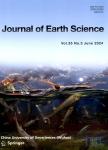Evolution,Extinction,Homology and Homoplasy of the Larger Benthic Foraminifera from the Carboniferous to the Present Day,as Exemplified by Planispiral-Fusiform and Discoidal Forms
Evolution, Extinction, Homology and Homoplasy of the Larger Benthic Foraminifera from the Carboniferous to the Present Day, as Exemplified by Planispiral-Fusiform and Discoidal Forms作者机构:Office of the Vice-ProvostUniversity College LondonLondonWC1H 0BTUK
出 版 物:《Journal of Earth Science》 (地球科学学刊(英文版))
年 卷 期:2022年第33卷第6期
页 面:1348-1361页
核心收录:
学科分类:070903[理学-古生物学与地层学(含:古人类学)] 0709[理学-地质学] 07[理学] 0708[理学-地球物理学] 0704[理学-天文学]
主 题:larger benthic foraminifera extinction homoplasy homology convergent/iterative evolution climate change
摘 要:Examples of evolution,extinction and homoplasy of the larger benthic foraminifera(LBF)occur throughout their *** the Carboniferous,LBF have thrived in carbonate-rich tropical and subtropical shallow-marine shelf *** high abundance and diversity are due primarily to their extraordinary ability to inhabit a range of ecological niches and by hosting a variety of *** relatively large,centimetre-scale sizes,made some forms very specialized and vulnerable to rapid ecological *** this reason,some LBF have shown a tendency to suffer periodically during major extinctions,especially when environmental conditions have changed rapidly and/or ***,however,makes them valuable biostratigraphic microfossils and,in addition,gives invaluable insight into the spatial and temporal process of biological evolution,such as convergent/homoplasy and homology/iterative *** the evolutionary behavior of two important morphological types that occurred throughout the history of the LBF are discussed,namely the planispiral-fusiform test as typified by the fusulinids in the Late Paleozoic and the alveolinids in the Mid-Cretaceous and Neogene,and the three-layered discoid lenticular test as characterized by the orbitoids in the Mid-to Late Cretaceous,the orthophragminids in the Paleogene,and lepidocyclinids in the Oligocene to *** the propensity of these forms to convergent and iterative evolution,with the repeated re-occurrence of certain morphological features,is essential in understanding and constructing their phylogenetic relationships more generally within the main groups of the *** insights gained from the history of these LBF have wider implications,and provide a more general understanding of the impacts of climate and ecological changes as driving forces for biological evolution.



